The Market Is Packed with ‘Pain Trades.’ How to Avoid Getting Hurt.

Stock market investors should be feeling pretty pleased. The Dow Jones Industrial Average recently made headlines for hitting 40,000—a long awaited milestone. While the index has pulled back, job growth and corporate profits remain solid and Friday’s inflation numbers suggest prices are slowly coming under control.
But a rising stock market isn’t without its pain points. Investors might be feeling they missed out on Nvidia, whose price has doubled this year, or AI more generally. Or they may be feeling a sense of disbelief about China, whose market has rebounded. The
is up more than 9% this year, despite many investors’ deep doubts regarding the nation’s economic recovery.
The term “pain trades”—highlighted in a recent note by Nicholas Colas, co-founder of DataTrek Research—addresses situations like those, where the market refuses to comport with conventional wisdom, irking investors across Wall Street and Main Street.
“It essentially says that when everyone agrees on a given idea, everyone is wrong,” writes Colas.
Unfortunately, pain trades are an inevitable part of investing. They stem from the fact that when too many investors want to place a good bet at the same time, it gradually ceases to be a winner. Eventually that attention and anxiety leads to unexplained volatility. Prices start to diverge from their fundamentals, rising on bad news or falling on good news, explains Colas.
Advertisement – Scroll to Continue
The disconnect between a seemingly clear investing case and what’s actually happening in the market leaves investors with difficult calls to make. Those who were early to the idea must consider whether to take profits; investors on the sidelines wonder how long they can continue to buck the rest of the market.
Either way, the situation tends to be uncomfortable.
Even legendary investors can get burned by pain trades. Colas recalls the case of George Soros who bet against tech stocks during the dot-com bubble, only to throw up his hands and go longer just as it burst. Ultimately, his fund shrank to less than half its previous size.
Advertisement – Scroll to Continue
How to handle the pain? Colas offers two points of advice.
First, don’t be irked by short-term losses. It is better to endure a 20% to 30% dip, typical for bear markets, than to miss out on all of an investment’s future gains.
Second, trust in the prospects of large-cap U.S. stocks, which consistently deliver for investors over the long term. “In the end, the worst Pain Trade is being underinvested,” Colas writes.
Write to Ian Salisbury at ian.salisbury@barrons.com





